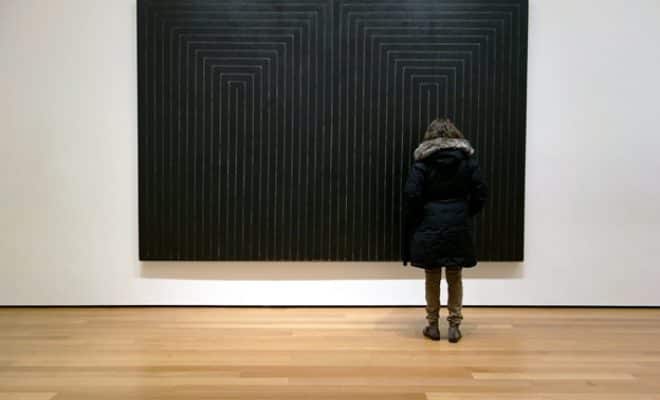There’s something about black. You feel hidden away in it. – Georgia O’Keeffe
Not many artists utilized the full potential of the color black, as Joan Witek did. The New York-based American artist has used the color black for life and preserved its purity in most of her artworks, most notably in The Road at Night (PS-28) (1984)and That He Be Known and Loved and Imitated (PS-22) (1984). She played with the stark contrast of black on a neutral background, wanting to express how black came alive when combined with lighter hues.
Scientifically, the black color is the absence of light. It doesn’t have a place on the visible color spectrum, as any rainbow will demonstrate. Over the centuries, black has represented mystery, fear, elegance, dark magic, and death. At specific points in history, it was revered; at others, it was avoided at all costs. Joan Witek described it best herself:
“One of the reasons I am attracted to black is indeed its dichotomies. It is sophisticated and primitive, emotional and intellectual, it is a color that everyone responds strongly to, in one way or another.”

Ancient Times
One of the first colors used in art, black has been around since prehistoric times. The Lascaux Cave in France, featuring cave drawings of paleolithic artists between 17,000 and 18,000 years ago, contains shapes of bulls, humans, other animals, and abstract symbols outlined by charcoal. Later on, the black color was obtained by burning bones or through powder of manganese oxide.
Ancient Egyptians saw black as a positive color. They associated it with the black rich soil of the Nile and considered it a color of fertility. Their god of the underworld, Anubis, would often turn into a black jackal to offer protection against evil.
In ancient Greece, black was widely used in making pottery. First, there was black-figure pottery against a red background. Then there was red-figure pottery against a black background. Ancient Romans associated black with death and mourning — they would wear black togas to funeral ceremonies. In ancient Rome, black was reserved for the lower classes, artisans, and craftsmen. Fabric dyed black would often fade to gray or brown because of the low quality of vegetable dyes.
Medieval Black
The classic labeling of the color black as ‘bad’ and color white as ‘good’ comes from, unsurprisingly, medieval times. In the 12th century, Benedictine monks wore black robes as a symbol of humility and patience. Cistercian monks, on the other hand, wore white robes to represent innocence and purity. The Benedictines were quick to accuse the Cistercians of their prideful appearance, while the Cistercians responded that black was the color of sin, death, and the devil.
Many medieval paintings depicted demons and devils as black, in contrast to vibrantly colored angels and saints.
In the 14th century, the perception of black as a sinful color began to change. High-quality black dyes and outfit regulations that prohibited nobility from wearing specific colors caused this major shift. Suddenly, black became a sign of importance, dignity, and power. Kings all over Europe, from Louis I in France to King Richard II in England to Charles V of Spain (as evident in the Portrait of Charles V by Titian (1548)), started wearing expensive, luxury black fabric. By the end of the 16th century, black was an essential color of royal families and their courts.
At the same time, artists in East Asia developed a technique called “ink wash painting.” Ink wash painting is a form of brush painting using only black ink in different concentrations. Entire scenes were depicted using just black. One of the great masters of this technique was Sesshu Toyo, a Japanese painter whose admirable skill is evident in works such as Splashed-ink Landscape (1495)and View of Amanohashidate (c. 1501-1507).

Black In Modern And Contemporary Art
In the late 19th century, Impressionists famously avoided black because of multiple reasons. Firstly, true black hardly ever existed in nature for their “en-plein air” paintings. Secondly, they much preferred changing hues than changing shades on their canvases.
However, it was Pierre-Auguste Renoir who declared, “I’ve been 40 years discovering that the queen of all colors was black.”
Indeed, in the 20th century, artists had no fear of this important color in art. Frank Stella, one of the most influential American minimalist and abstractionist artist, created a series of monochromatic canvases called Black Paintings (1958-1960). “What you see is what you see,” he explained about the series, implying that neither black nor his abstract concepts needed elaboration. Ad Reinhardt, another iconic American abstract painter, showcased an abstract painting in 1963 that was nothing but a black square at first glance. At closer inspection, this painting held different undertones and was divided into a grid of three-by-three squares. Each set of squares was colored with a different version of black.
To further explore this characteristic of the color black — the fact that no two black colors are alike — Reinhardt said, “There is a black which is old and a black which is fresh. Lustrous black and dull black, black in sunlight and black in shadow.”
Mainly due to fashion and the explosive popularity of Coco Chanel’s little black dress in 1926, black started being associated with individuality, refinement, and wealth.
In 2016, the Indian-born British artist Anish Kapoor provoked the fury of artists by securing the exclusive rights to use the blackest black color, known as Vantablack. Kapoor has been experimenting with the “super black” paint since 2014 and recently announced he will unveil a series of his first Vantablack sculptures during the Venice Biennale next year.
The Depth And Transcendence Of Black
As with any other color, there are no strict rules associated with black. Some cultures wear the color when saying their last goodbyes, while others celebrate it as a color of a union. To the rebels and extremists, it is a color of revolt. To fashionistas, it is a classic color that never goes out of style. It is the color of the punk movement and the goth subculture. On the one hand, it symbolizes traditionalism; on the other, it rejects authority.
Throughout history, we have witnessed how the subject represented the black color changed depending on the time period, external influences, and even the artist’s internal mental and emotional states. Some artists have embraced the black color like an old friend, dancing with it across all their artworks, and others stoutly avoided it, feeling it had no place on the canvas.
In this very moment, in the 21st century, black is in your own best and what you make of it ultimately. You can love it or not, but, as Joan Witek had put it, you cannot resist its magnetic duality.



![[Left] Kusama with her piece Dots Obsession, 2012, via AWARE, [Right] Yayoi Kusama (Courtesy Whitney Museum of American Art) | Source: thecollector.com](https://www.artdex.com/wp-content/uploads/2024/04/Left-Kusama-with-her-piece-Dots-Obsession-2012-via-AWARE-Right-Yayoi-Kusama-Courtesy-Whitney-Museum-of-American-Art-Source-thecollector.com--300x172.png)



